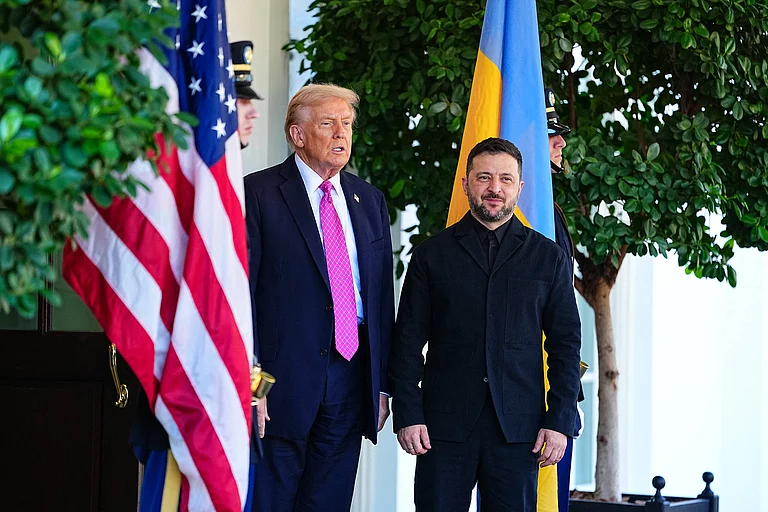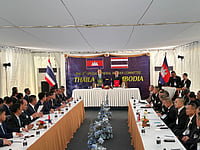The writ petition filed by the Centre for Indian Trade Unions (CITU) and Abhay Mehta, citizen of India, against the Union of India, Maharashtra state, the Central Electricity Authority (CEA), N.N. Patel, former deputy secretary, Department of Energy, Dabhol Power Company (DPC) and Enron Power Development Corporation (Enron), is the eighth Dabhol-related case, and the first one to be admitted by the court on the basis of prima facie evidence. If the plaintiffs are to be believed, the skullduggery involved in the Dabhol project makes the likes of the Bofors scandal—which involved a purchase worth Rs 1,400 crore and alleged pay-offs of Rs 65 crore—schoolboy stuff.
After all, the moneys involved are on a different scale altogether. The Dabhol deal means a payment of about $1.35 billion (Rs 4,750 crore) by the MSEB to DPC in the first year with a possibility of subsequent annual increase, for the next 20 years. Which could amount to around Rs 1,50,000 crore to Rs 2,00,000 crore in all, making it the largest-ever payment to be made by India in a contract with any party—private, government or an institution.
The four-point contention of the plaint:
The Dabhol project could go ahead only if the CEA granted both technical and economic clearance. The CEA granted technical clearance subject to certain conditions vide a letter to Dabhol Development Corporation dated November 26, 1993 (No.2/MHA/20/93-PAC/360) and signed by V.V.R.K. Rao, secretary, CEA. But economic clearance? The letter blandly states: "The aspects relating to import of fuel, foreign exchange outgo and deviation from Government of India tariff notification, including return on equity, has been examined by the FIPB (Foreign Investment Promotion Board) and the project has been found acceptable by them." This definitely is not an economic clearance from the CEA.
The letter states that the technical clearance has been given after the matter was discussed at a CEA meeting on November 12, 1993. Interestingly enough, another letter in the possession of the plaintiffs, from Power Secretary R. Vasudevan to CEA Chairman Y.P. Gambhir, dated November 11, 1993 (D.O. No. C-91/930JPC), that is, a day before the CEA meeting, reads: "With reference to our telephonic talk, I quote the extracts from the minutes of FIPE (sic, should read FIPB) meeting held on 5.11.93. 'Finance Secretary observed that the question of cost of power had been looked into and it had been found that it was more or less in line with other projects being put up in Maharashtra.'" So was the FIPB clearance also based on just one remark by Finance Secretary Montek Singh Ahluwalia?
Anyway, the CEA possibly could not stall a clear yes or no on economic clearance inde-finitely, feel the claimants. So, a year later, on December 23, 1994, CEA Secretary R.B. Mathur wrote to Pradip Baijal, joint secretary (IPC), Ministry of Power, giving economic clearance. But, the letter (No 1-3(13)/94-Secy) says: "As you are aware, the cost of power has been found reasonable by the Ministry of Finance and the CEA feels that since the cost of power is to be derived from the capital cost, the capital cost of Dabhol project may also be considered reasonable." This, say the petitioners, clearly shows that the CEA did not bother to study the economic reasonableness of the project on its own, as it obviously should have.
The above factors were heavy on the BJP-Shiv Sena combine's mind when it swept to power in Maharashtra in April last year and filed a suit against the MSEB and the DPC, accusing them of corruption and declaring the deal fraudulent. The state plaint states the CEA sanctioned the original project without conforming to the law. The sanction, it said, was given prior to the expiry of the statutory two-month period in which complaints or objections are invited. And despite there being 34 such letters, the DPC conveyed to the CEA that no objections had been received.
The notice sent out to invite objections itself didn't meet the requirements of Section 29 of the Electricity (Supply) Act, 1948, in that it didn't give the salient features of the agreement, said the new state government. To quote from the government's plaint, there is no mention of "the rate at which electricity would be purchased by the MSEB, the rate of interest on debt, the rate of return on equity... (the fact) that the project had been bifurcated into two phases which could run independently of each other and further that Phase I of the project would use distillate (diesel) rather than LNG as fuel."
The Power Purchase Agreement (PPA) was, in the first place, not an enforceable or concluded contract, pleads the state government. This because some of "the conditions precedent were effectuated and conceived in fraud and were not bonafide". Also, the PPA was in complete contravention of the notification in force, determining the terms and conditions for the sale of electricity by the new, private power-generating companies, points out the plaint. The tariff guidelines permit only a return of 16 per cent on equity but the PPA allows a return in excess of 25 per cent. Independent analysts peg the figure at 45 per cent.
The tariff notification obliges the tariff to be fixed for five years in advance. The tariff in this case is completely variable. The government plaint states that 'the PPA was thus contrary to law and violative of Section 23 of the Contract Act'. So can the hand be changed to fit the glove? In January 1994, about a month after the PPA was signed, the notification was apparently modified to suit the agreement. Rebecca Mark stated in her testimony to the US Senate Committee on Foreign Relations on March 7 last year: "The electricity boards had never negotiated complex commercial contracts. Return on equity and net present values were explained to some for the first time... A new tariff structure was devised." "The unholy haste with which the purported financial closure was sought to be achieved," the plaint accused, "was clearly in order to reap the benefit of the huge sum of $20 million admittedly already spent by the principal shareholder of Enron described by them euphemistically as 'educational expenses'."
Yet the current government has re-negotiated the deal and is scheduled to sign a contract for a 2,447-MW plant after making 'favourable' modifications. The government argues that only 'minor amendments' were made in the PPA. But, counter the plaintiffs in Case 2456, if the changes were minor, then the PPA's fraudulent nature stays.
However, say the petitioners, the changes in the PPA are actually substantial. The original contract indicated Rs 2.40 as the cost of a unit of electricity. The new government claims it has brought the rate down, apparently, to a 'levelised price' of Rs 1.86 per unit. But the fine print paints a less flattering picture, say the plaintiffs. While the Rs 2.40 rate was for 1997 prices of putting up the project, the levelised rate is based on 1995 prices. It's also based on other conditions: a discount rate of 17 per cent as opposed to the CEA's usual rate of 12 per cent; the US dollar rate has been taken as Rs 31.50 against the then existing rate of Rs 35; and an annual increase of 3.5 per cent of the unit rate from 1995 until the commissioning of the project.
In simple arithmetic, all this may mean an outgo of a starting unit price of, at least, Rs 2.46. Or an outgo of Rs 4,750 crore in the first year itself. Larger payments will have to be made in the following years based on several factors like increase of the US dollar rate, hike in fuel prices and so on. The original deal the current government castigated as fraudulent and a burden on the public would have involved an outgo of Rs 1,300 crore per year. The modified deal will cause a consumer in Maharashtra to pay nearly Rs 5 for a unit of power against Rs 2 approximately paid today.
This, contend the petitioners, destroys the notion widely spread by the Shiv Sena-BJP government that it is saving the country around Rs 25,000 crore with its amendments. The petitioners demand, that in public interest, the modified PPA be made a public document. Indeed, the office of the Accountant General has asked DPC to furnish a compliance to the observations made in its audit note on the project. Till date there has been no substantial compliance. The observations in the Accountant General's note are particularly damning of several clauses of the agreement (see box).
Meanwhile, there have been reports that the MSEB may have to bear a suspension cost of $250,000 (Rs 87 lakh approximately) per day from May 1 onwards for the delay in final clearances. The basis of this sum is unknown as no clause in the original PPA indicates so. Besides, it is unclear why the MSEB should pay for DPC's incapacity to get clearances on time. No one seems to be clear about this except to agree that this is a ruinously high sum. Says a DPC spokesperson: "Nobody wants to precipitate the problems till after the elections. The financial consortium (lenders to DPC) may take a more generous view. As of now, we don't know the exact situation."
No one does. Perhaps there is significance in Mark's words at the same Senate Committee presentation where she says that "as developers of infrastructure projects throughout the world we realise that with each project we negotiate we are paving a path that we hope many other investors will follow. If we allow political barriers to get in the way, the developing nations will fall further behind in their efforts to take their rightful place in the world economy." Sure, but the plaintiffs of Case 2456 would say, at what cost?


















.png?w=200&auto=format%2Ccompress&fit=max)







